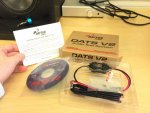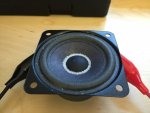 I wanted a tool that would let me take basic impedance measurements quickly and easily, so a few weeks ago I bought a "Dayton Audio DATS V2 Audio Test System" from Parts Express. You can find it here. It's $100 and ships free, and comes with a host of features. Windows only, unfortunately, but I've got a virtual machine I can run it in. I wanted it just for basic impedance graphing and export, but it also includes the ability to calculate Thiele/Small parameters (including Vas), test for voice coil rub, act as an oscilloscope and signal generator, and measure "advanced Wright Model parameters (Kr, Xr, Ki, Xi) for precision simulations" - whatever that means.
I wanted a tool that would let me take basic impedance measurements quickly and easily, so a few weeks ago I bought a "Dayton Audio DATS V2 Audio Test System" from Parts Express. You can find it here. It's $100 and ships free, and comes with a host of features. Windows only, unfortunately, but I've got a virtual machine I can run it in. I wanted it just for basic impedance graphing and export, but it also includes the ability to calculate Thiele/Small parameters (including Vas), test for voice coil rub, act as an oscilloscope and signal generator, and measure "advanced Wright Model parameters (Kr, Xr, Ki, Xi) for precision simulations" - whatever that means.The DATS system is very compact, which I definitely appreciate. Already it looks like a tool I could add to my hard case for travel. Being able to take on-site impedance response of transducers in and out of cabinets would be really helpful. The software is on CD, unfortunately, but I emailed their support ([email protected]) and they sent me a password protected download link. The box also contains setup instructions, which essentially tell you to read the manual, and a 1% tolerance 1kΩ calibration resistor - more on that in a minute. The DATS itself is basically a lump on a USB cable that then splits out to alligator leads. It has a very bright blue "on" LED, but aside from that it's as straightforward as it gets.
I found setup to be simple, especially given how awful the manual made it out to be. Rather than go through all the steps they suggested, which include changing sound card settings and messing around in windows' audio mixer, I just plugged it in and then opened the program. Windows recognizes the DATS as a USB audio device, the DATS software saw it immediately on startup, and so I clicked "Impedance Measurement" and a few seconds and a chirp later I had a graph that looked pretty reasonable on the screen. The sine sweep for impedance only takes about a second, and the resolution and display are quite good. Dayton Audio state that the hardware requires 90 seconds to stabilize, but I didn't wait and I didn't do any testing to see whether that's true.
Dayton Audio suggests that you calibrate the system, so that's what I did next. There are two calibration procedures, one for the impedance of the test leads and one against the 1kΩ resistor they supply. The tests are run separately, but the program walks you through them. Basically you short the leads to each other and run the first test, and DATS measures the impedance of its own test leads and then accounts for it in the future. Then you connect the system to any known resistor and sweep that, after telling the software what the resistance is supposed to be, and it adjusts accordingly. The screen shows the results (pre-calibration) for both tests, actually, and the resistor they supplied showed up as a nice horizontal line.
I was a little concerned about available drive level, but the DATS will apparently drive +5dBu (2V p-p) which ought to be plenty. The level can be adjusted down if you are measuring more delicate things like headphones or micro speakers, as I found out after sweeping the headphones I had on and getting a little threshold shift! As for overall accuracy, they seem to be pretty sure of themselves as stated in this white paper: http://www.parts-express.com/pedocs/tech-docs/dats-measurement-and-accuracy-white-paper.pdf So far I have found measurements to be reasonable and very stable across a wide range of transducers.
So far this little device does everything I wanted to and I'm perfectly happy with it, but I wanted to get a little deeper into the more advanced features. I asked it to calculate the T/S parameters of a B&C 8PS21 I just happened to have lying around, and even gave it the Mms so it could take a crack at Vas. You can see the results below, right next to a our published impedance data. The impedance, which is used to calculate the T/S parameters, is pretty close to what I expected. This is a brand new woofer that has not been exercised, unlike our published data which is after a "high level 20 Hz sine wave preconditioning test" to more accurately represent the long term behavior of the woofer. I don't actually have an amplifier, so I can't do a preconditioning test myself - this sort of thing doesn't normally matter except to speaker designers. It's hard to say how close the parameters will be after the suspension has been worked a little, and given mathematical and production line variance they may never match. I found the same with a Ciare woofer I also happen to have lying around brand new, so I feel the results are reasonable.


While I'm not likely to use the T/S parameter calculations in earnest ever, what did pique my interest was the software's rub & buzz tester. It would be really handy to be able to sweep woofers with this little tool and give them a pass/fail so I know they either need service or can still be used. Looking deeper into the description from Dayton Audio, the way this test works is to sweep for impedance at full voltage (e.g. 2V p-p) and then again at a much lower voltage. The idea is that if the voice coil is rubbing the motor won't have enough force to move it as easily at the lower drive voltage, and the Fs will move. So the test is based entirely on tolerance for Fs shift at varying drive levels, as in a reasonably designed and well functioning woofer Fs should not shift in the small signal range (for this woofer, probably anything below 20V).
 In practice, I think this test is probably useless for me. If a woofer is rubbing that badly I would expect to be able to feel it with my hands, or hear it with a sine sweep - two normal field tests that I can usually do with available tools. I was hoping for a finer grained test, like the Klippel system B&C uses for End of Line testing that will detect a few grains of salt on an 18" woofer - or equally small particles in the gap. So I tried to fool it by measuring a small woofer and then pouring a bunch of salt on it. This added mass, but added mass doesn't necessarily change Fs, and so the woofer passed with flying colors even at the most sensitive settings for the test. Oh well, honestly I didn't expect it to work since tools that can do that kind of sensitive EOL testing cost as much as a small car and require a microphone.
In practice, I think this test is probably useless for me. If a woofer is rubbing that badly I would expect to be able to feel it with my hands, or hear it with a sine sweep - two normal field tests that I can usually do with available tools. I was hoping for a finer grained test, like the Klippel system B&C uses for End of Line testing that will detect a few grains of salt on an 18" woofer - or equally small particles in the gap. So I tried to fool it by measuring a small woofer and then pouring a bunch of salt on it. This added mass, but added mass doesn't necessarily change Fs, and so the woofer passed with flying colors even at the most sensitive settings for the test. Oh well, honestly I didn't expect it to work since tools that can do that kind of sensitive EOL testing cost as much as a small car and require a microphone.In short, I found the DATS V2 test platform to be everything I was hoping it to be: A compact, portable, easy to use system that can take impedance measurements in a wide range of situations. If that's what you're looking for it's an inexpensive way to get this ability. For folks looking for a pass/fail, or T/S parameter calculation, or any of the other things this tool can do it is extremely helpful but those sorts of tests are much more difficult to interpret. Even different high dollar test programs will often disagree on Thiele/Small calculations of the same woofer, and small production variances that will have no meaningful effect in a cabinet can result in very different numbers in practice. Subscribers to Voice Coil magazine are likely familiar with this issue from Vance Dickasons review of pro and consumer audio transducers. That said, I am aware of no other tool in this price range that is in such a handy form factor and requires so little effort to set up.
